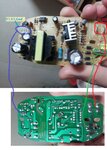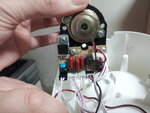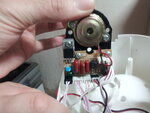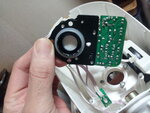areebaa
Member level 2

Hi,
i have small portable Humidifier which was working fine. one day i cleaned it and before drying i connected to mains by mistake. a big spark came out. so i opened its pcb where i saw blown fuse. after repairing the fuse i connected it after drying.but again the fuse was blown with big spark.
there are two PCB'S in the humidier. (please see attachment)
1- power supply part (dual output) input =220V , output label (V1 ,V2, Gnd) level not known
2- control part for ultrasonic transducer and fan
so i separated suuply stage and powered from a cell phone charger (5V,300mA), fan part is working with slow speed , but i dont to how much voltage is neeeded for ultrasonic part , how can we verify ?
how we can make dual supply easily at home ?
Thank You




i have small portable Humidifier which was working fine. one day i cleaned it and before drying i connected to mains by mistake. a big spark came out. so i opened its pcb where i saw blown fuse. after repairing the fuse i connected it after drying.but again the fuse was blown with big spark.
there are two PCB'S in the humidier. (please see attachment)
1- power supply part (dual output) input =220V , output label (V1 ,V2, Gnd) level not known
2- control part for ultrasonic transducer and fan
so i separated suuply stage and powered from a cell phone charger (5V,300mA), fan part is working with slow speed , but i dont to how much voltage is neeeded for ultrasonic part , how can we verify ?
how we can make dual supply easily at home ?
Thank You





